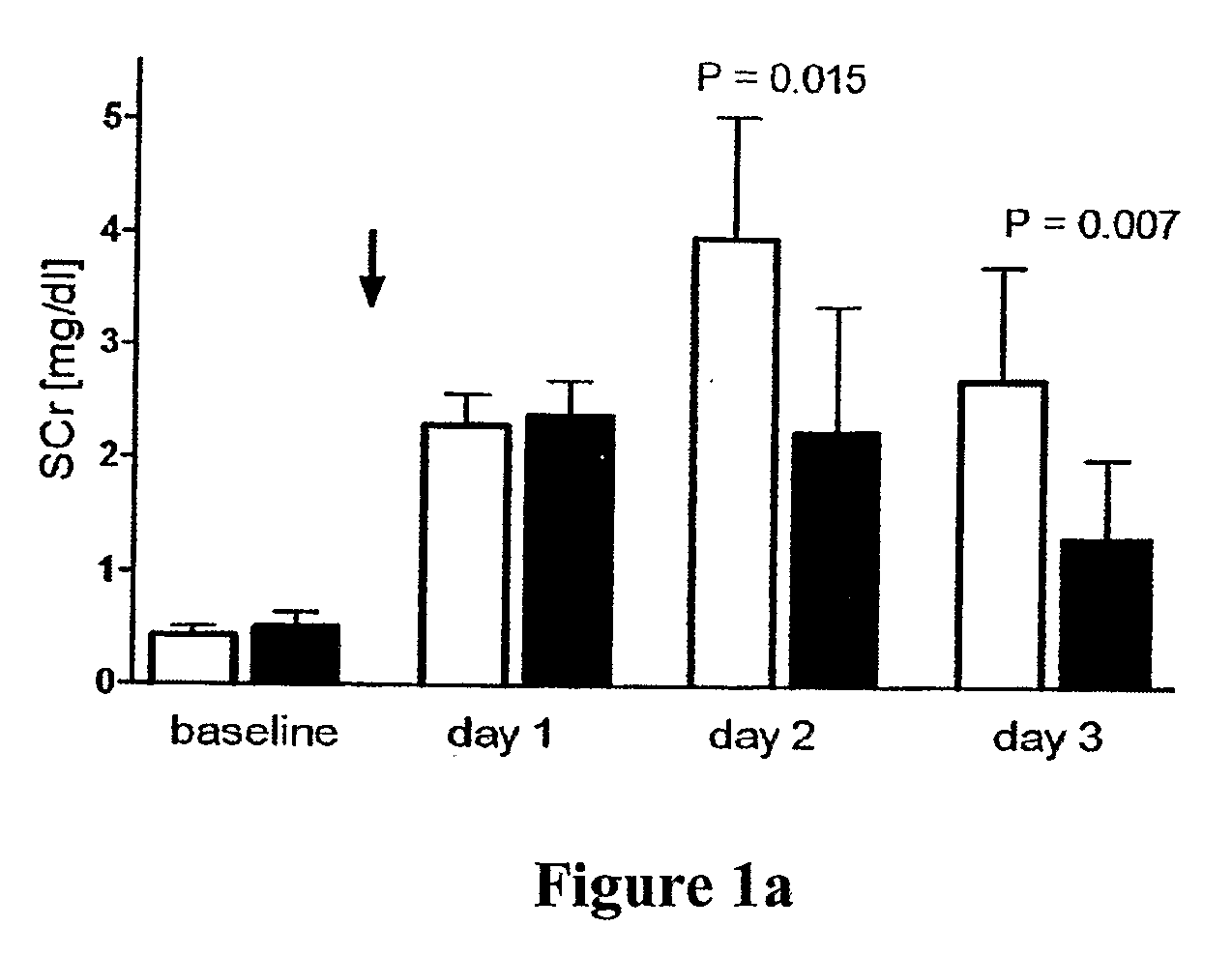Therapy of Kidney Diseases and Multiorgan Failure with Mesenchymal Stem Cells and Mesenchymal Stem Cell Conditioned Media
- Summary
- Abstract
- Description
- Claims
- Application Information
AI Technical Summary
Benefits of technology
Problems solved by technology
Method used
Image
Examples
example 1
Isolation of MSC
[0063]MSC were harvested under anesthesia from femurs of normal adult rats (male or female, Sprague-Dawley or Fisher 344 strain) by flushing the femurs with sterile PBS using a syringe with a 25 gauge needle. The isolated cell aspirates were spun to pellet the cellular content of the aspirate. The pellet was resuspended in culture media (MEM or DMEM / F12 with 10-20% Fetal Calf Serum, Sigma-Aldrich, St. Louis, Mo.), optionally filtered through a 70 μm mesh (Becton & Dickinson, San Jose, Calif.), and plated in 75 cm2 primary culture flasks with culture media. Non-adherent cells were removed after 72 hours in culture by repeated rinsing with culture media. Adherent cells were passed at low density into new flasks and expanded to about 3-5×106 MSC / flask. Cells were spindle shaped in appearance. MSC phenotype was confirmed by differentiation into osteocytes and adipocytes with specific differentiation media (Pittenger et al., Science 284: 143-147, 1999). Optionally, the ad...
example 2
MSC CM Preparation
[0064]MSC isolated as described in Example 1 were used to generate MSC CM. MSC were expanded to high subconfluence, i.e. about 3-5×106 MSC / T-75 flask and the fetal calf serum was removed from the cultures by repeated washing of the MSC with serum free medium. Conditioning of serum free media was then accomplished by culturing MSC under room air (pO2˜21%) or under hypoxic conditions (pO2≦5%) for 1-3 days. The cell free supernatant (MSC CM) was collected, filtered through a 0.22 μM filter and frozen under sterile conditions at −120° C. Prior to testing in vitro or administration to rats with ARF, the MSC CM was thawed and aliquots were either used without further manipulation or boiled for 20 min at 100° C. prior to administration as a control. The absolute protein concentration in the serum free MSC CM was at the lower detection limit of the biuret protein assay.
example 3
MSC Administration
[0065]Ischemia / reperfusion-type of ARF (“ischemic ARF”) was induced in anesthetized rats by timed clamping of both renal pedicles, thereby interrupting the blood supply to the kidneys causing an “ischemic” insult resulting in acute loss of kidney function, i.e., ARF. A model of severe ARF was established using 45 minutes of bilateral renal ischemia. The 45 minute bilateral renal ischemic treatment resulted in a mortality of 50% at 72 hrs post reflow and a glomerular filtration rate of <5% of normal. Histological examination of the severe ARF model shows wide spread tubular necrosis and severe vascular congestion in the corticomedullary junction. A moderate ARF model was established using 35 minutes of bilateral renal ischemia. The moderate ARF model exhibits a serum creatinine level of about 1.5 mg / dL and a mortality of <10%. These models of ARF very closely resemble the most common and most serious form of ARF in patients with shock, sepsis, trauma, after vascular...
PUM
 Login to View More
Login to View More Abstract
Description
Claims
Application Information
 Login to View More
Login to View More - R&D
- Intellectual Property
- Life Sciences
- Materials
- Tech Scout
- Unparalleled Data Quality
- Higher Quality Content
- 60% Fewer Hallucinations
Browse by: Latest US Patents, China's latest patents, Technical Efficacy Thesaurus, Application Domain, Technology Topic, Popular Technical Reports.
© 2025 PatSnap. All rights reserved.Legal|Privacy policy|Modern Slavery Act Transparency Statement|Sitemap|About US| Contact US: help@patsnap.com



